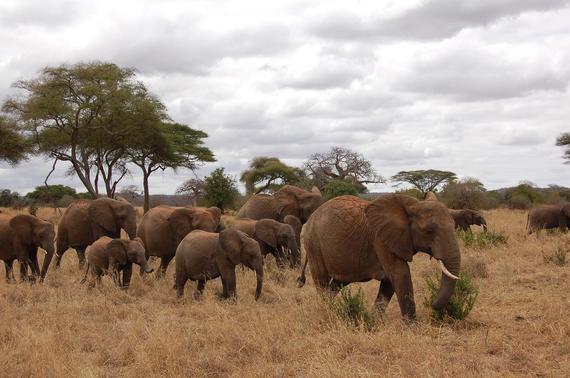It's hard to imagine a world without majestic wildlife roaming Africa's savannahs. More and more, however, the unimaginable seems to be taking root - and it is unsettling beyond belief.
Years ago, I had the privilege of studying wildlife in Kenya as a graduate student. While I was researching Grevy's zebra, I observed other amazing species: elephant, gerenuk, and lion, as they searched for food and water while their land and water sources became more scarce. Habitat loss was one of the biggest threats to wildlife then, and it continues now to be a major threat: as agricultural activity and industry increase, there is less space for wildlife.
We have the ability to maintain healthy wildlife populations in their habitats by marrying sustainable development with biodiversity conservation. Almost 20 years ago, I joined the U.S. Agency for International Development (USAID) as an American Association for the Advancement of Science Fellow to learn how to better integrate conservation and development. During my tenure, I've observed enormous success in community conservation, with more land put under conservation to the benefit of both local people and wildlife. I've seen growing wildlife populations and more secure and prosperous communities with whom they share their land.
But these hard-won gains are threatened by a global poaching crisis so severe that more than 100,000 African elephants were slaughtered for their tusks in just three years, and rhino poaching in South Africa has increased to over 1,000 per year from 2013 to 2015, and the remaining tigers in the wild have dropped to fewer than 3,200. The trade in illegal wildlife, valued at billions of dollars, has evolved into one of the biggest black markets in the world. This trade is undoing decades of conservation and development work, risking the futures of both precious wildlife species and the local communities who benefit from ecotourism and other wildlife-friendly enterprises.
This crisis has serious implications for the security and prosperity of people around the world. The illegal wildlife trade often involves sophisticated transnational organized criminal networks, whose activities fuel corruption, discourage foreign investment, and eviscerate natural systems, with far-reaching consequences.
Protecting wildlife is not just a matter of protecting our planet. It is also a security issue, an economic security issue, and an international development issue that is critical to all our interests.
To encourage scientific and technological innovation, USAID, in partnership with the National Geographic Society, the Smithsonian Institution, and TRAFFIC, the wildlife trade monitoring network, launched the Wildlife Crime Tech Challenge in 2015 to harness innovations to address this crisis. Four Grand Prize Winners were recognized this week at the International Union for Conservation of Nature (IUCN) World Conservation Congress in Hawaii for their groundbreaking solutions and potential impact in the fight against wildlife crime:
New York University is tackling the explosion of illegal wildlife trade over the internet with their web-based tool that incorporates a computational model with machine learning to help law enforcement and other groups monitor online trade with greater efficiency.
The New England Aquarium wants to find illegal wildlife products hidden in legal, legitimate trade through their "smart invoice" technology that quickly digitizes customs paperwork for real-time analysis that identifies potential fraud.
The University of Washington wants to save pangolins - scaly anteaters that look like armadillos and are one of the most trafficked mammals in the world. Their solution will analyze the DNA of pangolin scales and meat seized by law enforcement, and use this information to pinpoint where those animals were poached.
The National Whistleblower Center will fight the corruption that fuels wildlife trafficking through a web portal where potential whistleblowers can securely report evidence of wildlife crime, seek legal advice, and learn about their rights.
These incredible innovators are supplying solutions to more ably curb wildlife crime by providing indisputable evidence to trace the traffickers, support law enforcement, incentivize insiders to report corruption, and curb consumer demand.
You can assist our efforts to battle wildlife crime- get involved, follow our progress on the Wildlife Crime Tech Challenge website, and learn more about our innovators. Connect with them to support their efforts at info@wildlifecrimetech.org and wildlifecrimetech.org. To learn more about USAID's Forestry and Biodiversity work, including combating wildlife trafficking, visit our website.
Together, we can build a world without wildlife crime.
This post is part of a series on the World Conservation Congress taking place this week. Held every four years, it brings together about 6,000 people, including heads of state, government officials, business leaders, representatives from indigenous groups, scientists, academics, influencers, educators, artists and NGOs, from all over the world to discuss and decide on solutions to the world's most pressing environmental challenges. To read all the posts in this series click here
